1. Introduction
This paper presents preliminary results of the REMOWE project. The overall objective of the project is, on regional levels, to contribute to a decreased negative effect on the environment by reduction of carbon dioxide emission by creating a balance between energy consumption and sustainable use of renewable energy sources. Reduction of carbon dioxide emissions and use of renewable energy sources are broad areas and this project will focus on energy resources from waste and actions to facilitate implementation of energy efficient technology in the Baltic Sea region within the waste-to-energy area. The focus is to utilize waste from cities, farming and industry for energy purposes in an efficient way. The project seeks to facilitate the implementation of sustainable systems for waste-to-energy in the Baltic Sea region and specifically, in a first step, in the project partner regions. The project’s operation time is 12/2009- 12/2012.
The project partnership consists of the Mälardalen University, with the School of Sustainable Development of Society and Technology coordinating the project, and The County Administrative Board of Västmanland in Sweden, Savonia University of Applied Sciences, Centre for Economic Development, Transport and the Environment for North Savo, and University of Eastern Finland (UEF) in Finland, Marshal Office of Lower Silesia in Poland, Ostfalia University of Applied Sciences, Fachhochschule Braunschweig / Wolfenbüttel in Germany, Klaipeda University in Lithuania, and Estonian Regional and Local Development Agency (ERKAS) in Estonia.
2. Milestones of the REMOWE project
As the first task, partner regions investigate the current status, the bottle-necks and the needs for development and innovation. Partnering regions will then jointly study possible future status and approaches to be followed, taking into consideration the characteristics of each region. Here, tailored innovation processes will be organized in five project regions. These innovation processes will result in action plans for supporting SMEs as well as recommendations for improving regulations and strategies in the regions. Possibilities to build a regional model of the waste-to-energy utilisation will be piloted in the project, with North Savo in Finland as a target region. This model could be a decisionsupport system for policy-making and investments.
The project activities are divided into 5 work packages. Work Package 1 concerns project management and Work Package 2 contains the project communication and information activities. In Work Package 3 the current status of the partner regions are explored, in Work Package 4 the possible future status is investigated and in Work Package 5 modelling of a sustainable regional waste-to-energy production will be studied.
The work presented in this report is part of the work in Work Package 3. The aim of this Work Package is to investigate the current status in the whole chain of waste- to-energy utilisation in each partner region. The results from this work package are important background information for the activities in Work Package 4 and 5. The first step in development of action plans and strategies is to investigate the current conditions and systems from which the development has to start. By describing the current status in the different partner regions it will also be possible to learn from each other and find best practices that can be transferred to other regions. The aim is also to gather basic information needed for modelling of possible future systems and their environmental impacts in Work Packages 4 and 5. Data is being gathered concerning:
- Waste generation in farming, cities, industry
- Energy use and infrastructure • Organic wastes composition and properties
- Biogas potential of different waste substrates
- Existing systems and technology used for sorting, utilisation and use of residues for/in waste-to-energy systems including economic profitability and system performance
- Relevant governing rules, legislation, regional interpretations and current development ideas • SMEs interests in the waste-to-energy area and current development ideas
- Regional current situation in waste advisory services
The current status in the different partner regions will then be compared and best practices that can be transferred to other regions will be identified. This will be done within a workshop with all partners.
3. Characteristics of the project regions
Five regions of the Baltic Sea region, representing various administrative units, participate in the REMOWE project (Figure 1):
- Eesti (Estonia) – the whole country,
- Województwo Dolnośląskie (Lower Silesia) – one of the 16 regions of Poland,
- Klaipedos, Telsiu, Siauliu, Taurages apskritis (Western Lithuania) – 4 counties of Lithuania,
- Pohjois-Savo (North Savo Region) – a province in Eastern Finland,
- Västmanlands län (the County of Västmanland) – one of 21 counties in Sweden.
Germany is also represented in the project, however, as opposed to all the other participants they act as experts without any specific region.
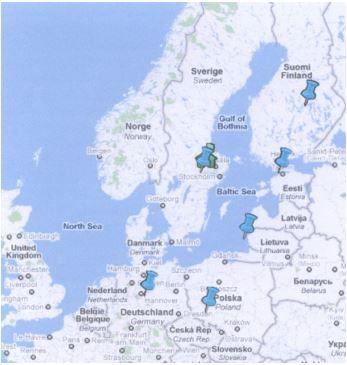
Tab. 1 shows the general characteristics of each region and the entire project area. The total area is 113,195 km2 and its population amounts to 5.75 million. Lower Silesia is the largest region in terms of population – 2.9 million, while the populations of the smallest regions (in Sweden and Finland) amount to approximately 250 thousand residents.
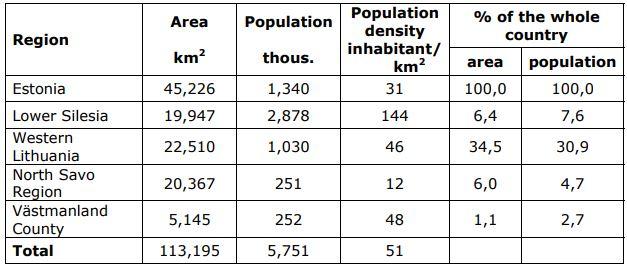
4. Status of renewable energy utilisation in the representative countries
Fig. 2 presents country average shares of renewable energy in final energy consumption in 2005 along with respective targets for 2020. Sweden is leading with 39.8% of renewable energy in 2005 and the target of 49% in 2020, followed by Finland, Estonia and Lithuania. Poland had clearly the lowest share of renewables (7,2%) in 2005 and also relatively lowest target of 15% in 2020.
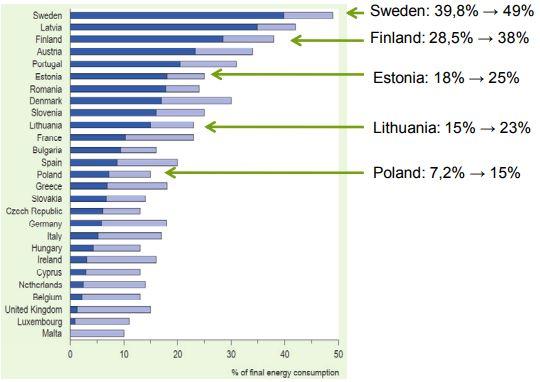
5. Potential waste to energy sources
The following waste and by-products have been specified as renewable energy sources:
- municipal waste,
- industrial waste,
- municipal sewage sludge,
- products, by-products and waste from agriculture and forestry.
In the following sections a comparison of main data concerning waste management and energy recovery from municipal waste, sewage sludge and biomass from agriculture and forestry is given. The comparison is limited to two regions: Lower Silesia (the most populated region) and Västmanland (the smallest region). These regions represent, respectively, the least and the most advanced countries in terms of renewable energy utilisation.
5.1 Municipal waste
Waste management in the two regions differs significantly, both in terms of quantity of waste generated as well as its treatment (see Fig 3.). Specific waste generation amounted to 691 kg/inhabitant in Västmanland while in Lower Silesia only to approximately 330 kg/inhabitant in 2008. In Lower Silesia 86.5% of the generated waste is deposited onto landfills, while in Västmanland only 8% of waste is landfilled. In the latter region 50% of waste is incinerated with energy recovery and 41% of waste undergoes recycling. In Finland in 2008, municipal waste amounted to 520 kg/inhabitant, from which 51% was landfilled, 17% incinerated with energy recovery and 32% recycled [4].
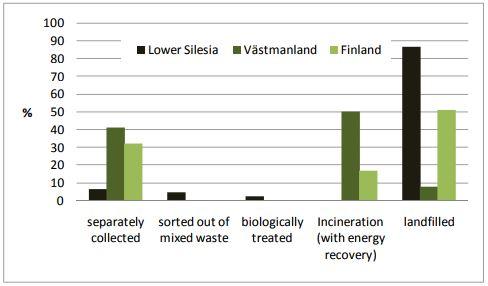
5.2 Municipal sewage sludge
Lower Silesia and Västmanland also differ with regard to the number of waste water treatment plants and the level of biological treatment of sewage sludge in these plants. Six waste water treatment plants located in Västmanland are equipped with enclosed fermentation chambers and utilise energy from biogas. Total production of biogas amounts to 2,165 million m3 /year. In Lower Silesia there are 203 waste water treatment plants, of which:
- seven plants collect biogas and use it for electricity and heat generation (co-generation),
- four plants collect biogas and use it for heat generation only,
- ten plants generate biogas without collecting it (open fermentation chambers).
Currently in Lower Silesia 8.6 million m3 /year of biogas is collected in the fermentation chambers of waste water treatment plants. In Västmanland the respective figure is 2.2 million m3 /year.
In North Savo, there are 35 municipal waste water treatment plants, of which one plant digests waste water sludge and collects biogas for electricity and heat generation. In 2008, 1.1 million m3 /year of biogas was produced in this plant, of which was converted 2090 MWh electricity and 4222 MWh heat. Only 8000 t sludge is used in biogas production out of total 47000 t that is produced annually [5] [6].
Energy generation potential from biogas from municipal sewage sludge is estimated to 130 GWh/year in Lower Silesia,19 GWh/year in Västmanland and 18 GWh/year In North Savo.
5.3 Products, by-products and waste from agriculture and forestry
Manures for soil fertilisation, are not classified as waste, but as organic fertilisers. Faeces intended for fermentation do acquire the status of waste and are subject to waste management legislation. In the case of plant biomass, some of it may be treated as by-products, some other part as waste. Also, agricultural products can be used to produce energy in e.g. fermentation technology, together with animal manure.
The total energy potential of manure in North Savo is estimated to 198 GWh/a, which is based on the number of domestic animals, estimated manure generation, statistical properties of manures and batch reactor experiments [7] [8] [9] [10].
Tab. 2 provides a comparison of the energy potential of animal manures generated in both regions. In both cases the total quantities are significant. In the case of Lower Silesia it is equivalent to the yearly energy production by a plant with a capacity of about 17 MW.
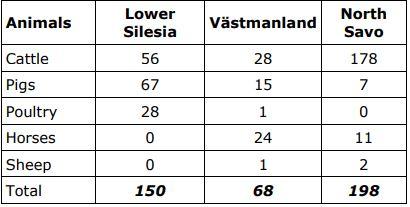
6. Infrastructure for waste treatment and energy recovery
Waste management infrastructure in the two regions differs significantly. In the case of Västmanland, a significant portion of the waste is processed outside the region. It concerns in particular, the incineration of municipal waste in large regional installations. In the region there are 15 recycling stations under operation as well as one methane co-fermentation plant, which treats separately collected biowaste and two landfill sites accepting pretreated waste (landfilling of untreated waste is forbidden). In Lower Silesia, almost all municipal waste is processed in the region, in 18 plants. There are also 42 active landfills receiving municipal wastes.
7. Conclusions
Waste management in the Lower Silesia region is significantly less developed than waste management in the County of Västmanland in Sweden. This applies to both the levels of separate collection and recycling, as well as biological and thermal treatment. In 2008, the portion of municipal waste which is landfilled in Lower Silesia amounts to approximately 86.5%, while in Västmanland the respective portion is only 8%. In Finland, 51% of the municipal waste was landfilled in 2008.
Municipal waste, sewage sludge, industrial waste, and waste and by-products from agriculture are a significant source of energy with majority thereof being renewable energy.
This article is based on results of analyses conducted during the project cofinanced by the European Union under the Baltic Sea Regional Programme (Project No. #034, REMOWE). The content of the article contains only opinions of the authors and do not necessarily reflect the position of the European Union.
Authors
Emilia den Boer (1), Ryszard Szpadt (1), Eva Thorin (2) , Ari Jääskeläinen (3) , Laura Malo (3,4), Tuomas Huopana (5)
1 Institute of Environment Protection Engineering, Wrocław University of Technology Wybrzeże Wyspiańskiego 27, 50-370 Wrocław, Poland
2 Mälardalen University, P.O. Box 883, SE-721-23 Västerås, Sweden
3 Environmental Engineering, Teaching and Research, Savonia University of Applied Sciences, Microkatu 1 C, P.O. Box 6, FI-70201 Kuopio, Finland
4 Center for Economic Development, Transport and the Environment for North Savo, Sepänkatu 2 B, P.O. Box 1049, FI-70100 Kuopio, Finland
5 The Department of Environmental Science, The University of Eastern Finland, Yliopistonranta 1, P.O. Box 1627, FI-70211 Kuopio, Finland
[vc_tta_accordion active_section=”0″ no_fill=”true” el_class=”lahteet”][vc_tta_section title=”Bibliography” tab_id=”1458134585005-b3f22396-5506″]
[1] den Boer, E., Szpadt, R., den Boer, J., Ciesielski, S., Pasiecznik, I and Wojtczuk, O. Current status of the waste-to-energy chain in Lower Silesia, Urząd Marszałkowski Województwa Dolnośląskiego i Politechnika Wrocławska, Wrocław, 2011.
[2] Thorin E., et al. Current status of the waste-to-energy chain in the County of Västmanland, Sweden. Mälardalen University, Västerås, 2011.
[3] Olivier, J.G.J., Tuinstra, W., Elzenga, H.E., van den Wijngaart, R.A., Bosch, P.R., Eickhout, R., Visser, M. Consequences of the European Policy Package on Climate and Energy Initial assessment of the consequences for the Netherlands and other Member States, Netherlands Environmental Assessment Agency,2008
[4] Tilastokeskus. Jätetilasto 2008. Retrieved 8.6.2011 from: http://www.tilastokeskus.fi/til/jate/2008/jate_2008_2009-12-16_fi.pdf
[5] Vahti, The waste data base, data from 2006 to 2009. Additional information available from: http://www.ymparisto.fi/default.asp?contentid=57264
[6] Malo, L., Koponen, L., Jääskeläinen, A. Current status of the waste-toenergy chain in the county of North Savo, Finland. Center for Economic Development, Transport and the Environment for North Savo and Savonia University of Applied Sciences, Kuopio 2011. Will be available from: http://www.remowe.eu
[7] Tike, The statistics of Finnish agriculture and food chain, 2010, Retieved 20.5.2011 from: http://www.mmmtike.fi/www/fi/palvelut/tietopalvelut/tietojen_tilaus.php
[8] Viljavuuspalvelu Oy, Manure statistics from 200 to 2004, Mikkeli, Retrieved 20.5.2011 from: http://www.viljavuuspalvelu.fi/user_files/files/kotielain/lanta_tilastot.pdf
[9] Huopana T., Energy efficient model for biogas production in farm scale, Master’s Thesis, Renewable Energy Programme, The University of Jyväskylä, 2011, Retrieved 20.5.2011 from: http://urn.fi/URN:NBN:fi:jyu- 201103211905
[10] Huopana T., and co. Becoming article about Regional biogas production in North Savo area, The University of Eastern Finland.
[/vc_tta_section][/vc_tta_accordion]



